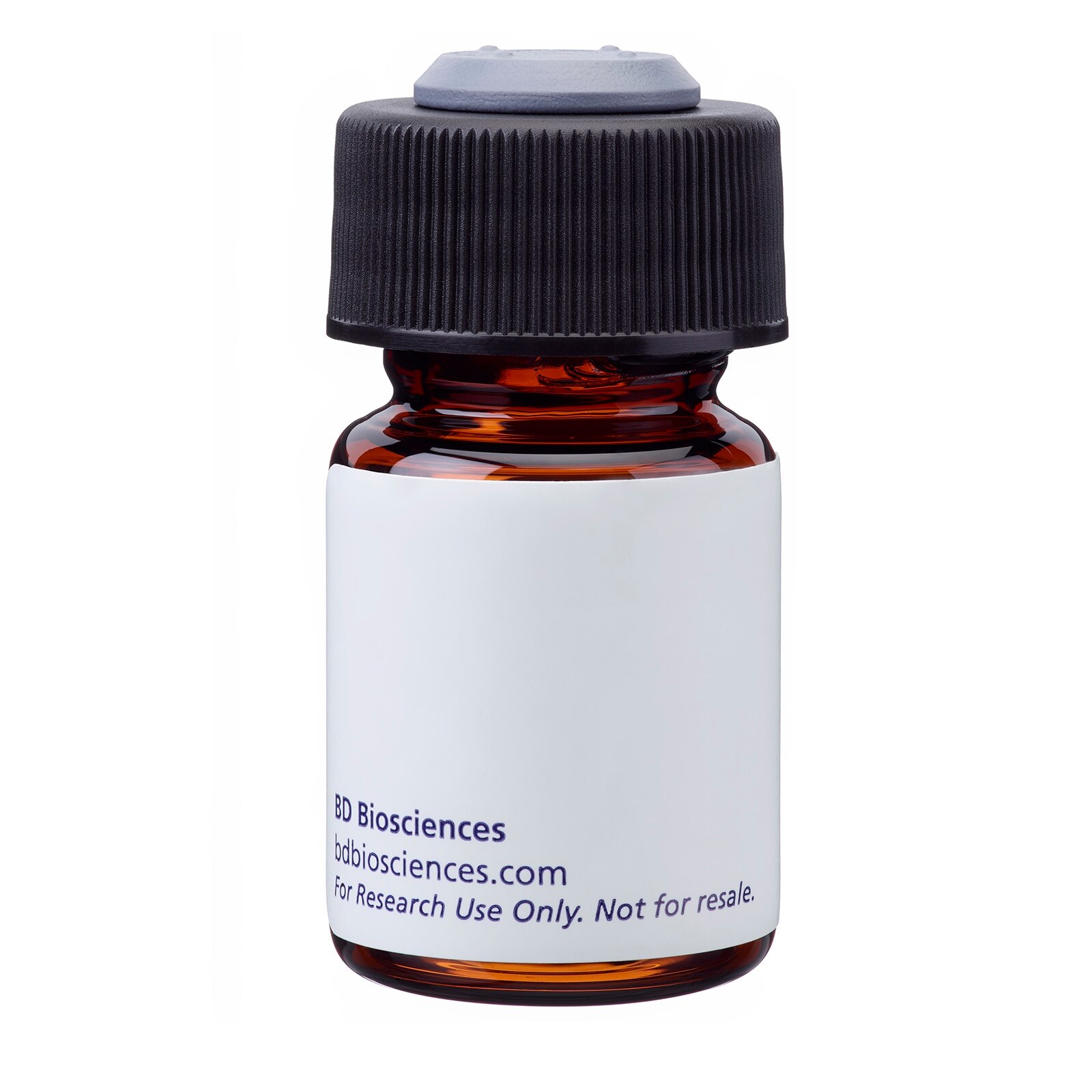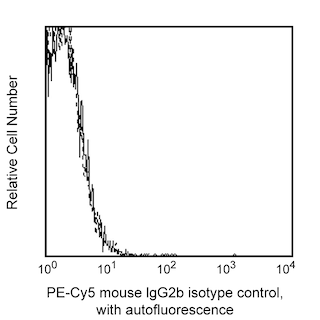Old Browser
This page has been recently translated and is available in French now.
Looks like you're visiting us from {countryName}.
Would you like to stay on the current country site or be switched to your country?




Flow cytometric analysis of HLA-DR expression on human peripheral blood lymphocytes. Whole blood was stained with either PE-Cy™5 Mouse Anti-Human HLA-DR (Cat. No. 551375; solid line histogram) or PE-Cy™5 Mouse IgG2b κ Isotype Control (Cat. No. 555744; dashed line histogram). Erythrocytes were lysed with BD Pharm Lyse™ Lysing Buffer (Cat. No. 555899). Fluorescent histograms were derived from gated events with the side and forward light-scattering characteristics of viable lymphocytes.


BD Pharmingen™ PE-Cy™5 Mouse Anti-Human HLA-DR

Regulatory Status Legend
Any use of products other than the permitted use without the express written authorization of Becton, Dickinson and Company is strictly prohibited.
Preparation And Storage
Product Notices
- This reagent has been pre-diluted for use at the recommended Volume per Test. We typically use 1 × 10^6 cells in a 100-µl experimental sample (a test).
- Caution: Sodium azide yields highly toxic hydrazoic acid under acidic conditions. Dilute azide compounds in running water before discarding to avoid accumulation of potentially explosive deposits in plumbing.
- Source of all serum proteins is from USDA inspected abattoirs located in the United States.
- PE-Cy5 is a tandem fluorochrome composed of R-phycoerythrin (PE), which is excited by the 488 nm light of an Argon ion laser and serves as an energy donor, coupled to the cyanine dye Cy5, which acts as an energy acceptor and fluoresces at 670 nm. BD Biosciences Pharmingen has maximized the fluorochrome energy transfer in PE-Cy5, thus maximizing its fluorescence emission intensity, minimizing residual emission from PE, and minimizing lot-to-lot variation.
- Please observe the following precautions: Absorption of visible light can significantly alter the energy transfer occurring in any tandem fluorochrome conjugate; therefore, we recommend that special precautions be taken (such as wrapping vials, tubes, or racks in aluminum foil) to prevent exposure of conjugated reagents, including cells stained with those reagents, to room illumination.
- PE-Cy5 is optimized for use with a single argon ion laser emitting 488-nm light. Because of the broad absorption spectrum of the PE-Cy5 tandem fluorochrome, extra care must be taken when using dual-laser cytometers which may directly excite both PE and Cy5™.
- For fluorochrome spectra and suitable instrument settings, please refer to our Multicolor Flow Cytometry web page at www.bdbiosciences.com/colors.
- PE-Cy5 tandem fluorochromes have been reported to bind some classes of human macrophages and granulocytes via Fc receptors, and PE has been reported to bind to mouse B lymphocytes via Fc receptors. Preincubation of mouse leukocytes with Mouse BD Fc Block™ purified anti-mouse CD16/CD32 mAb 2.4G2 can reduce the non-specific binding of PE-Cy5-conjugated reagents to mouse B cells. However, PE-Cy5 conjugated reagents should not be used to stain splenocytes of SJL, NOD, and MRL mice as B lymphocytes and/or other leukocytes have been reported to non-specifically stain regardless of the use of Mouse BD Fc Block™ (the CD72c complex has been implicated for PE-Cy5 binding in these strains). Reagents conjugated to PE, PerCP, PerCP-Cy5.5, APC, and APC-Cy7 tandem fluorochrome can be used on leukocytes from these mouse strains.
- Cy is a trademark of GE Healthcare.
- Species cross-reactivity detected in product development may not have been confirmed on every format and/or application.
- Please refer to www.bdbiosciences.com/us/s/resources for technical protocols.
Companion Products





The TU36 monoclonal antibody specifically binds to a monomorphic epitope on major histocompatibility complex (MHC) Class II HLA-DR antigens expressed on B cells, activated T cells, and antigen presenting cells. The antibody detects the MHC Class II αβ complex and not the isolated α or β chains. This antibody fixes complement.

Development References (3)
-
Pawelec G, Ziegler A, Wernet P. Dissection of human allostimulatory determinants with cloned T cells: stimulation inhibition by monoclonal antibodies TU22, 34, 35, 36, 37, 39, 43, and 58 against distinct human MHC class II molecules. Hum Immunol. 1985; 12(3):165-176. (Biology). View Reference
-
Ziegler A, Heinig J, Muller C, et al. Analysis by sequential immunoprecipitations of the specificities of the monoclonal antibodies TU22,34,35,36,37,39,43,58 and YD1/63.HLK directed against human HLA class II antigens. Immunobiology. 1986; 171(1-2):77-92. (Biology). View Reference
-
Ziegler A, Uchańska-Ziegler B, Zeuthen J, Wernet P. HLA antigen expression at the single cell level on a K562 X B cell hybrid: an analysis with monoclonal antibodies using bacterial binding assays.. Somatic Cell Genet. 1982; 8(6):775-89. (Immunogen). View Reference
Please refer to Support Documents for Quality Certificates
Global - Refer to manufacturer's instructions for use and related User Manuals and Technical data sheets before using this products as described
Comparisons, where applicable, are made against older BD Technology, manual methods or are general performance claims. Comparisons are not made against non-BD technologies, unless otherwise noted.
For Research Use Only. Not for use in diagnostic or therapeutic procedures.
Report a Site Issue
This form is intended to help us improve our website experience. For other support, please visit our Contact Us page.